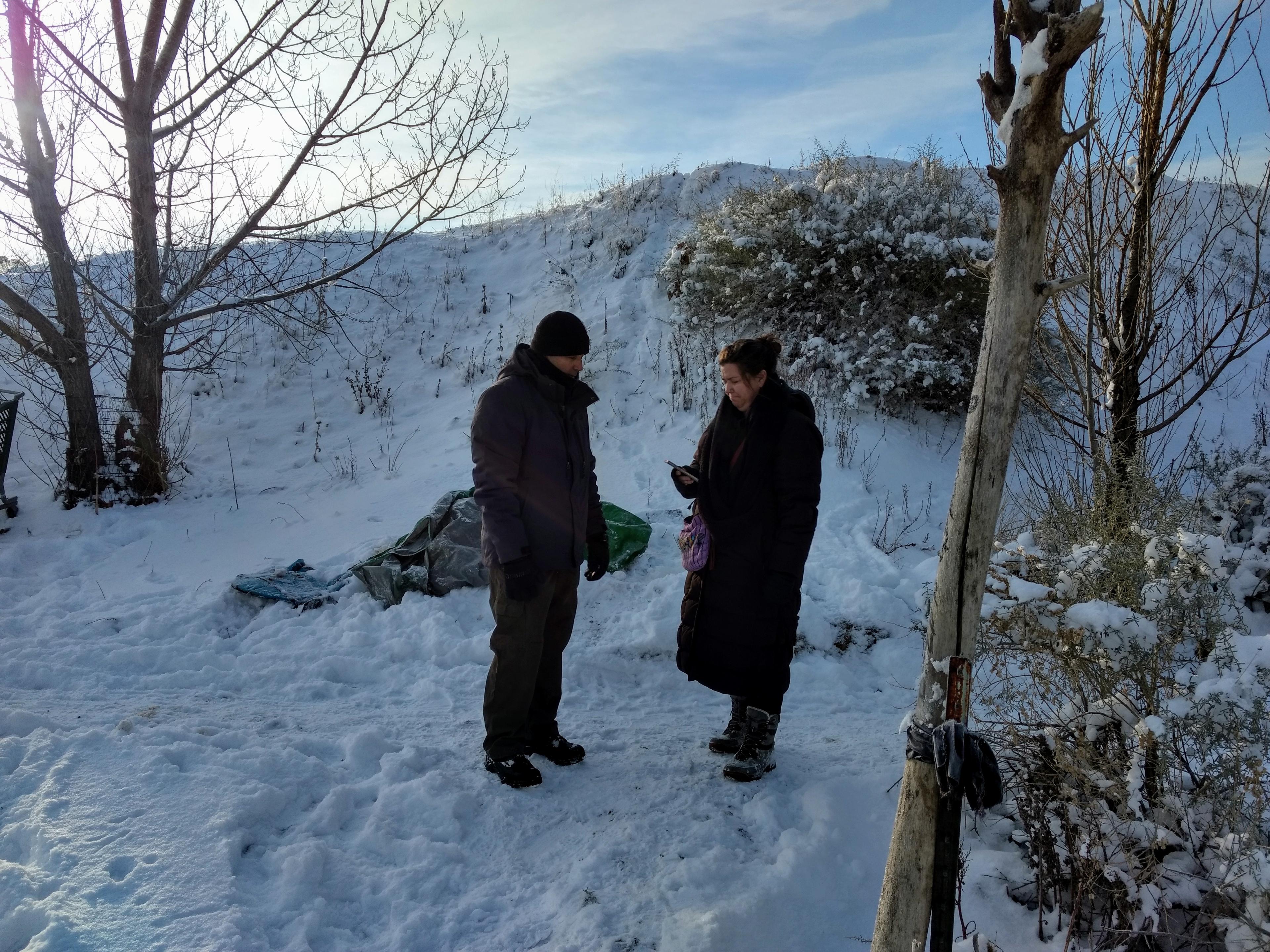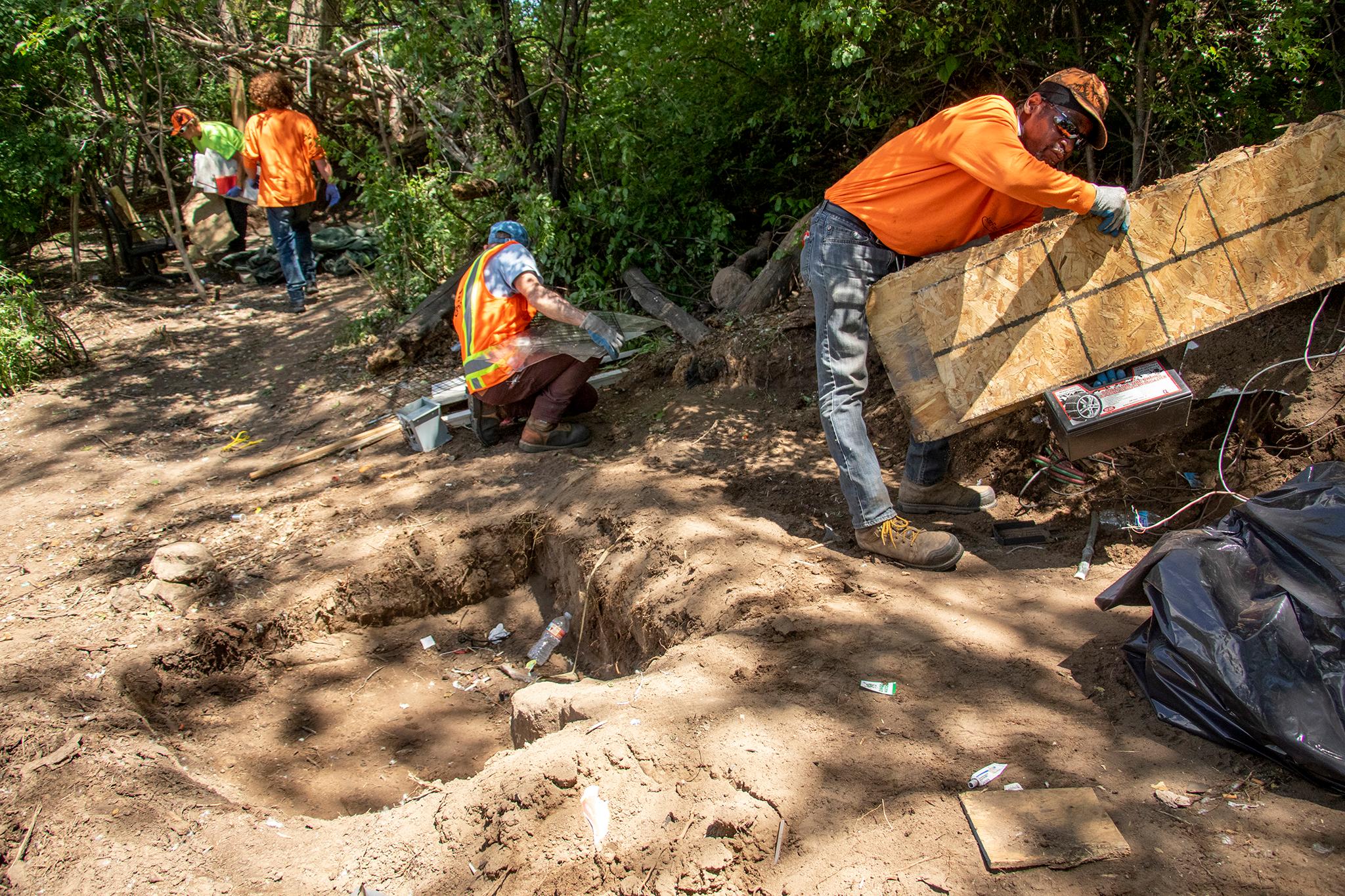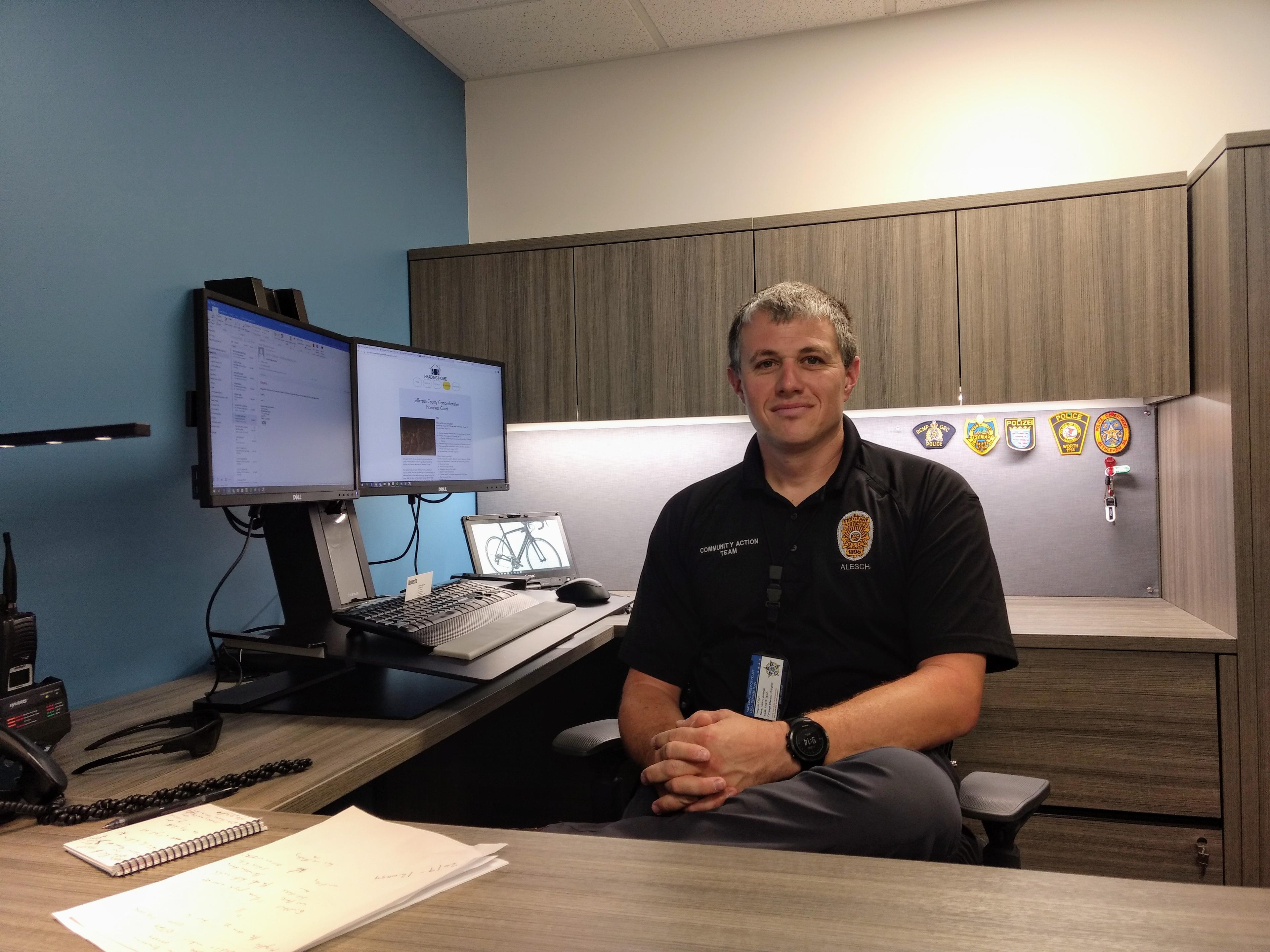Questions about homelessness often get put to the cops.
It's not just homeowners asking whether trespassing laws or camping bans apply when they want urban campers moved along. Concerned neighbors also turn to the police expecting them to get someone in obvious distress to a shelter or to medical help.
"We're the ones who find them freezing in winter or overheated in summer," said Jon Alesch, who heads the Lakewood Police Department's Community Action Team.
Officials in the Denver suburb searching for answers about the scope of homelessness have queried Alesch. He offers them the latest results from the Point in Time, a survey of people living in homelessness taken on one winter day across the country. It's seen as the best data available.
But "how do you, realistically, in one 24-hour period, expect to get everywhere people are?" Alesch said.
He recalled one recent year in which, according to the Point in Time, Jefferson County, where Lakewood is located, had just four veterans with no homes.
"We know that that's not true," he said.
Alesch has been exploring how to get closer to the truth.
For about a year, he has been talking with law enforcement colleagues in places such as Arvada, Golden, Westminster and Wheat Ridge, as well as with local government and school officials, librarians, park managers, health workers and people who provide food, clothing and other services to the needy. The conversations have led to ambitious action: Jefferson County is for the first time undertaking its own comprehensive homelessness count in hopes of gathering data to better deploy resources and perhaps make the case that more need to be devoted to addressing homelessness.
As part of the count, for eight and a half hours on each of five days next week 500 volunteers are to spread out along the creeks and into the foothills of Jefferson County, which sprawls over 774 square miles. The canvassers will approach people at parks and libraries and knock on doors at cheap motels. They will be putting questions about homelessness to the experts: those experiencing it.
"We hope to be able to paint a better picture, a more accurate picture of homelessness in Jefferson County," said Kate Skarbek, a senior management analyst for Westminster Parks, Recreation and Libraries who like Alesch has been a driving force behind the comprehensive count.
Skarbek has worked with the Metro Denver Homelessness Initiative on an annual Point in Time that covers seven counties. Skarbek turned to the initiative, which is in charge of the regional Point in Time, for support as she helped plan the Jefferson County survey. She said her appreciation has grown for what the initiative has done year after year since 2001.

Skarbek has worked with the initiative on the Point in Time, a count that she says "doesn't capture what homelessness looks like in the suburbs."
In large part that is because the suburbs don't have Denver's shelters and other service providers.
"If you're living in an area that doesn't have concentrated areas of services ... there's no one place to (go to) count," Skarbek said.
"The Point in Time is a useful tool more for urban areas. It's also a useful snap shot," Skarbek said.
In preparing for the Jefferson County count, which might be seen as a short video in comparison to Point in Time's photograph, Skarbek studied the example of Sonoma County, California. After fires destroyed thousands of homes and displaced many people in northern California in 2017, Sonoma County officials were concerned the usual Point in Time methods would not yield enough information. They supplemented their 2018 count with a telephone survey targeting people who would not traditionally be considered homeless, including families living doubled up. Officials reasoned that knowing the number of people in such unstable situations would help planners addressing the aftermath of disaster brace for families tipping into homelessness.
Planning for the Jefferson County count also was informed by the Metro Denver Homelessness Initiative's survey language and training materials.
"It's not a competition," said Diane Howald, who leads Point in Time for the Denver-based regional group. "I'm excited that people are ready to do the work and get to know their community."
Howald added the information gleaned about where to find people experiencing homelessness during the Jefferson County count could help determine where to send outreach workers during future Point in Time surveys. It also could guide officials as they determine what services the community needs and where to locate providers.
"I am all in to support any and all of this," Howald said.
The Jefferson County effort comes as Denver's neighbors are responding in a variety of ways to housing issues.
In a special election last month, Lakewood voters approved a 1 percent cap on housing construction that affordable housing advocates worry will make it even more difficult to build homes that can be offered at below-market rates. Earlier this month, Aurora's city council adopted a new zoning code that included provisions designed to make it easier to build affordable housing, though some members had called for a greater effort on that front. In a vote last month, Centennial's city council banned camping on city-owned property. The Centennial vote came weeks after officials in Englewood, with no need for a formal camping ban, cleared people living in homelessness from a stretch of the Platte River bank, citing concerns about keeping order and maintaining cleanliness in the area.

Englewood, meanwhile, has joined the fellow Arapahoe County cities of Littleton and Sheridan in planning a joint assessment similar to Jefferson County's, in hopes of learning how to better deploy resources to lessen homelessness.
The tri-city count is still in the early planning stages and likely to take place late this year or early next, Littleton Deputy City Manager Randy Young said. He added conversations so far have already raised awareness.
"A lot of people have incorrect information about the homeless," Young said. He offered himself as an example, saying he had once assumed many people chose to live on the streets.
"What I've learned from this process to date is if that's a percentage at all, it's a very small percentage," he said.
"Everybody's become more aware that we need to be more proactive," Young said. "We're just trying to get a little bit deeper and better understanding."
Phyllis Resnick, an economist and executive director of the Colorado Futures Center think tank, said such efforts speak "to something that I don't think gets enough attention around here, which is the suburbanization of poverty."
That's driven in part by the new trendiness of central Denver neighborhoods, Resnick said. As higher-end housing is built there, the low- and moderate-income families that once called neighborhoods such as Five Points home are moving to suburbs that once were attractive because of their very distance from the urban core, and now are seen as lacking walkability and access to transit options other than cars.
Jennifer Newcomer, director of the Piton Foundation's Shift Research Lab, said she is getting more and more requests from city governments and nonprofits in Denver's suburbs for help identifying where support services for needy families should be located. The Piton Foundation focuses on childhood development, health and other socio-economic issues.
"A lot of these suburban communities are kind of having to play catch up," Newcomer said.
The effort can be daunting.
The 500 volunteers that Jefferson County wants to conduct its planned homelessness assessment over a week are as many as were deployed in total on Jan. 28-29 for seven counties -- Adams, Arapahoe, Boulder, Broomfield, Denver, Douglas and Jefferson -- for the regional Point in Time.
While the Point in Time looks at just one day a year, it provides data that can be compared over decades and among communities nationwide. That helps experts identify trends and try to predict future needs. The Jefferson County assessment will be hard to replicate annually. Skarbek said Jefferson County might repeat the effort only every five years, or perhaps every other year.
While it won't be conducting a telephone survey as Sonoma County did, Jefferson County is using extra methods to expand local knowledge.
Point in Time canvassers, for example, end the conversation if people they are questioning report having paid for their own hotel or motel room instead of relying on a government or charity voucher. The Jefferson County surveys probe further in an effort to understand how much longer people think they can continue to pay for themselves -- in other words, how secure they are in their housing. The Jefferson County volunteers also will be asking individuals to report on where they have slept over the last three nights, which will yield a sense of how often people have to move along. The Point in Time focuses on just one night. And the surveys include questions about whether people are receiving food, employment or other services and whether they face transportation, language or other barriers to getting help.
In the planning stages, Skarbek said, she and others couldn't put their hands on a comprehensive list of food pantries in the county. That's a gap that was identified and can now be addressed even before the survey is completed, she said.
Jefferson County's field survey will be bolstered by information that hospitals, schools and service providers are collecting throughout the month of August as part of the effort.
The Jefferson County school district has staff engaged with families over time and practiced at tracking homelessness among its students. It's part of any district's responsibilities under McKinney-Vento, federal legislation on homelessness that includes guarantees that vulnerable children have access to education. This August, JeffCo schools will ask students whether they have been contacted by volunteers or other agencies as part of the comprehensive count.
"If they haven't, we will ask them to participate in the survey to add to the county-wide effort data," district spokeswoman Diana Wilson said in an email. "We know it's important to get a handle on the numbers and needs of this segment of our community in order to plan for and provide the best services to support them."
The district identified 3,135 students living in homelessness during the 2017-18 school year. The 2019 Point in Time put the number of people of all ages experiencing homelessness on one night at 434 in Jefferson County.
Of those counted in the schools, 251 students were living in shelters. More than 2,500 had had to move in with relatives or friends, which could be better than a shelter, but could also be as precarious as the term "couch surfing" implies.
Families doubled up are sometimes split up, with friends making room for the children but mom left to sleep in her car, said Skarbek, who helped design the Jefferson County survey. Or they are crowded into apartments and breaking terms of leases that limit occupancy, placing their hosts at risk of eviction.
"They don't have that security, with a place to feel they have the rest of the world at bay," Skarbek said.
"It's almost ensuring generational poverty is established or continues."
In an attempt to understand the extent of couch surfing, the surveys developed for Jefferson County's comprehensive count include questions about how long people think they will be able to stay in one place.
Staff at Centura Health's St. Anthony Hospital in Lakewood are taking part in the comprehensive count, asking about the housing situation of patients who appear at risk. Some hospital staff will also volunteer for the count in the field, said Monica Buhlig, Centura's metro Denver group director for community health.
She said St. Anthony emergency room staff regularly see people experiencing homelessness.
"We can treat people for the immediate needs. But when it's time to say goodbye, it's a tough situation," Buhlig said.
Where will a discharged patient who has no kitchen keep medication that needs to be refrigerated? Will a mother living in her car eat a recommended diet, or put her own health at risk in order to make sure her children are fed?
"In Jefferson County, this is a hidden epidemic," Buhlig said. "The fact of the matter is that there are so many families experiencing homelessness and we don't see them."
The results of the comprehensive count are expected to be available next month, after the raw data is evaluated by the same analysts who help prepare the metro Denver Point in Time reports. Police Sgt. Alesch expects the report to be eye-opening for policymakers.
And "for the public," he said, "so they have a better understanding of what the situation is."











